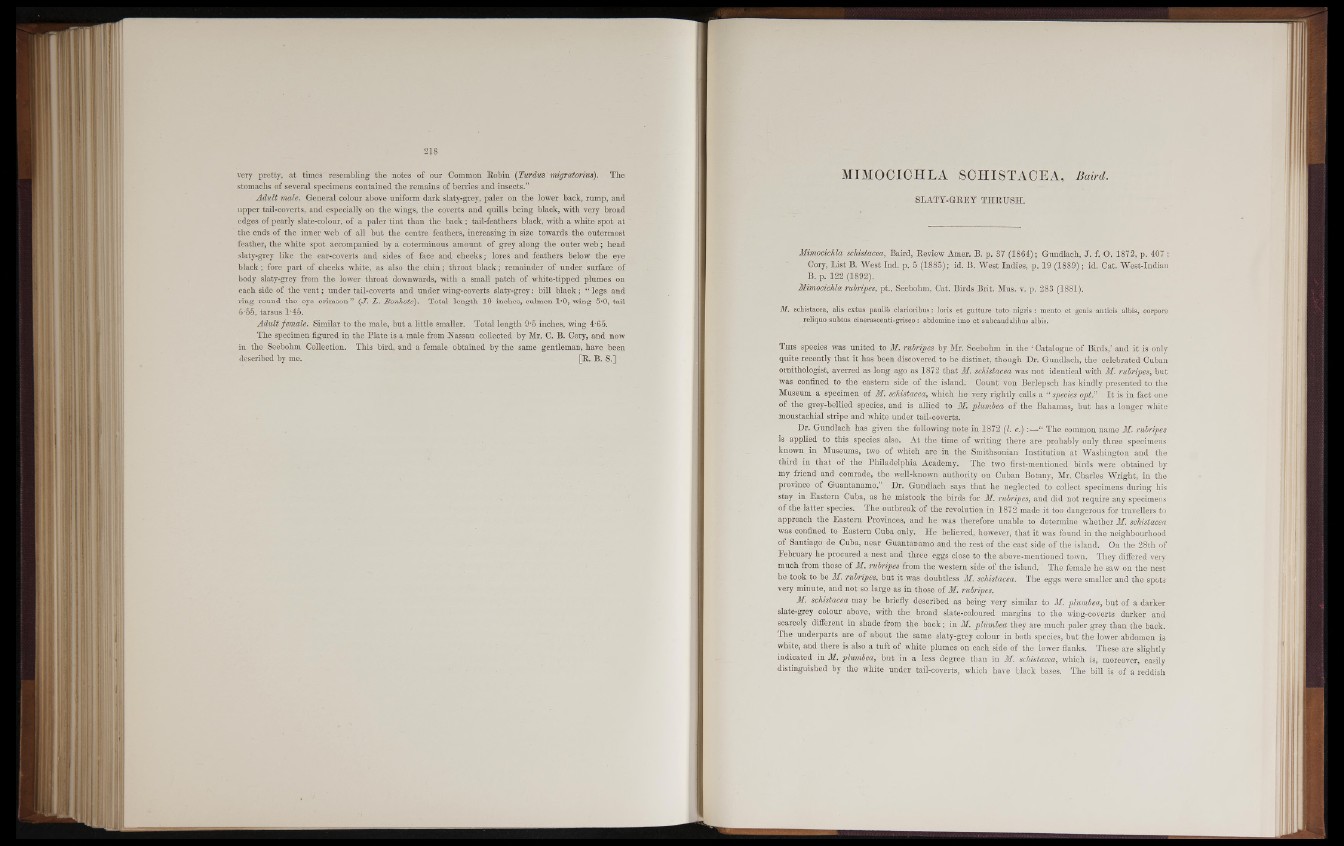
very pretty, at times“ resembling the notes of our Common Robin (Turdus migratorius). The
stomachs of several specimens contained the remains of berries and insects.”
Adult male. General colour above uniform dark slaty-grey, paler on the lower back, rump, and
upper tail-coverts, and especially on the wings, the coverts and quills being black, with very broad
edges of pearly slate-colour, of a paler tint than the back; tail-feathers black, with a white spot at
the ends of the inner web of all but the centre feathers, increasing in size towards the outermost
feather, the white spot accompanied by a coterminous amount of grey along the outer web; head
slaty-grey like the ear-coverts and sides of face and cheeks; lores and feathers below the eye
black | fore part of cheeks white, as also the chin; throat black; remainder of under surface of
body slaty-grey from the lower throat downwards, with a small patch of white-tipped plumes on
each side of the vent; under tail-coverts and under wing-coverts slaty-grey: bill black; “ legs and
ring round the eye crimson” (J. L. Bonhote). Total length 10 inches, culmen 1*0, wing 5’0, tail
5'55, tarsus T45.
Adult female. Similar to the male, but a little smaller. Total length 9-5 inches, wing 4-65.
The specimen figured in the Plate is a male from Nassau collected by Mr. C. B. Gory, and now
in the Seebohm Collection. This bird, and a female obtained by the same gentleman, have been
described by me. - [R.. B. S.]
MIMOCICHLA SOHISTAOEA, Baird.
SLATY-GREY THRUSH.
Mimocichla schistacea, Baird, Review Amer. B. p. 37 (1864); Gundlach, J . f. O. 1872, p. 407 ;
Cory, List B. West Ind. p. 5 (1885); id. B. West Indies, p. 19 (1889) ; id. Cat. West-Indian
B. p. 122 (1892).
Mimocichla rubripes, pt., Seebohm, Cat. Birds Brit. Mus. v. p. 283 (1881);
M. schistacea, alis extus paullb clarioribus: loris et gutture toto n ig ris : mento et genis anticis albis, corpore
reliquo subtus cinerascenti-griseo: abdomine imo et subcaudalibus albis.
T his species was united to M. rubripes by Mr. Seebohm in the ‘ Catalogue of Birds/ and it is only
quite recently that it has been discovered to be distinct, though Dr. Gundlach, the celebrated Cuban
ornithologist, averred as long ago as 1872 that M. schistacea was not identical with M. rubripes, but
was confined to the eastern side of the island. Count von Berlepsch has kindly presented to the
Museum a specimen of M. schistacea, which he very rightly calls a “ species opt.” I t is in fact one
of the grey-bellied species, and is allied to M. plumbea of the Bahamas, but has a longer white
moustachial stripe and white under tail-coverts.
Dr. Gundlach has given the following note in 1872 (I. c.) :—“ The common name M. rubripes
is applied to this species also. At the time of writing there are probably only three specimens
known in Museums, two of which are in the Smithsonian Institution at Washington and the
third in that of the Philadelphia Academy. The two first-mentioned birds were obtained by
my friend and comrade, the well-known authority on Cuban Botany, Mr. Charles Wright, in the
province of Guantanamo. Dr. Gundlach says that he neglected to collect specimens during his
stay in Eastern Cuba, as he mistook the birds for M. rubripes, and did not require any specimens
of the latter species. The outbreak of the revolution in 1872 made it too dangerous for travellers to
approach the Eastern Provinces, and he was therefore unable to determine whether M. schistacea
was confined to Eastern Cuba only. He believed, however, that it was found in the neighbourhood
of Santiago de Cuba, near Guantanamo and the rest of the east side of the island. On the 28th of
February he procured a nest and three eggs close to the above-mentioned town. They differed very
much from those of M. rubripes from the western side of the island. The female he saw on the nest
he took to be M. rubripes, but it was doubtless M. schistacea. The eggs were smaller and the spots
very minute, and not so large as in those of M. rubripes.
M. schistacea may be briefly described as being very similar to M. plumbea, but of a darker
slate-grey colour above, with the broad slate-coloured margins to the wing-coverts darker and
scarcely different in shade from the back; in M. plumbea they are much paler grey than the back.
The underparts are of about the same slaty-grey colour in both species, but the lower abdomen is
white, and there is also a tuft of white plumes on each side of the lower flanks. These are slightly
indicated in M. plumbea, but in a less degree than in M. schistacea, which is, moreover, easily
distinguished by the white under tail-coverts, which have black bases. The bill is of a reddish